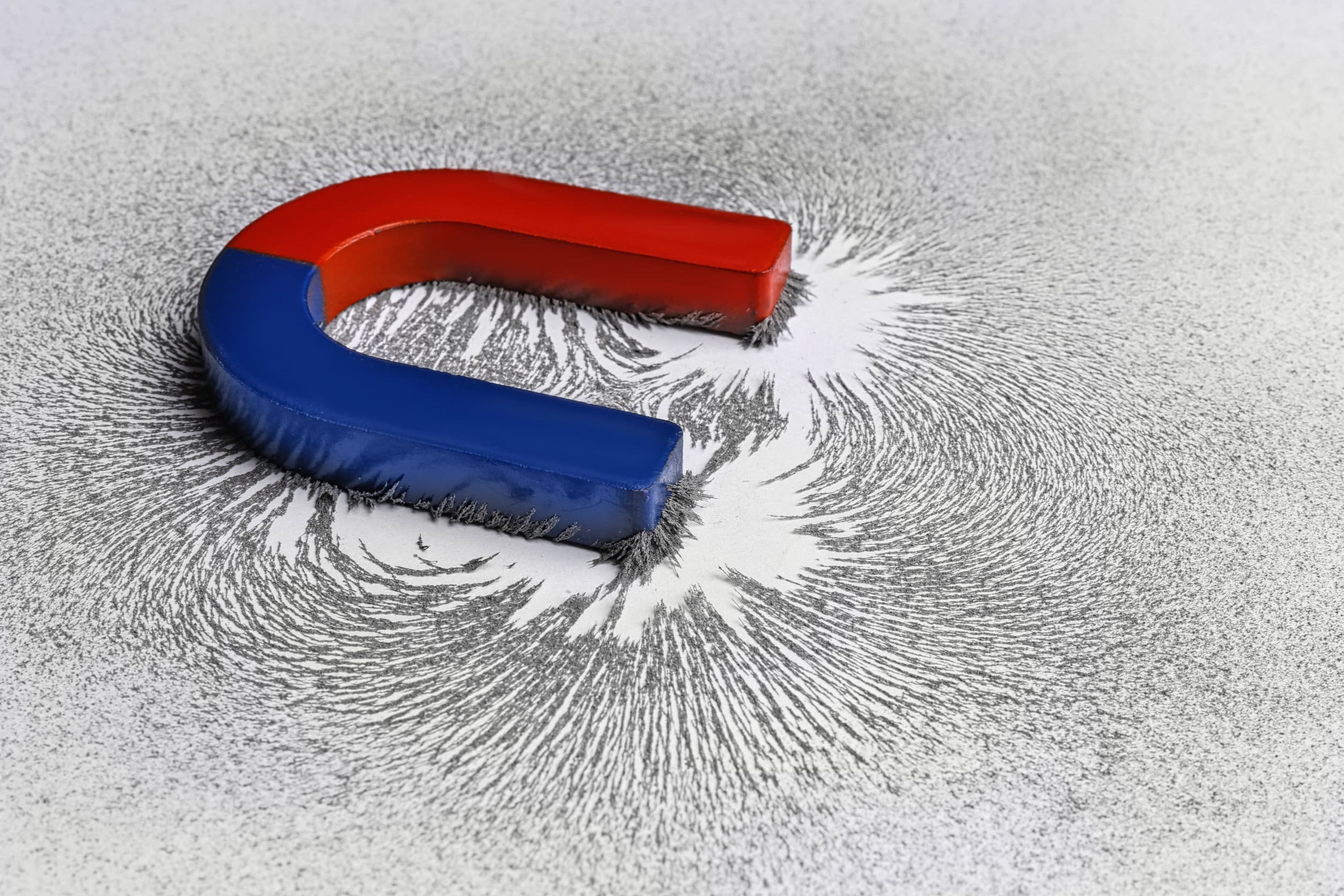In this post
A magnetic field is also produced around any electrical conductor when current is flowing. For example, a magnetic field is produced around a wire which has an electrical current running through it. The strength and shape of the magnetic field depends upon the size of the current flowing through the wire and the shape of the conductor used. Current is measured in amperes (amps).
Straight wire
The magnetic field created around a straight wire is represented using a diagram showing a series of circles drawn at right angles to the wire which runs through the middle. This shows that the magnetic field acts at right angles to the direction of the current. As the circles get further away from the wire, the gaps between them get larger, showing that the magnetic field is getting weaker the further it is away from the central wire. The magnetic field pattern diagram for the straight wire is shown below:
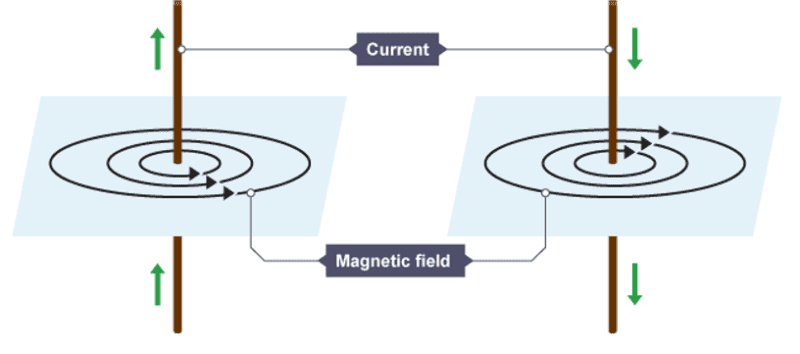
Flat circular coil
The wire could also be wrapped into a flat circular coil. A flat circular coil is made by coiling the wire around a cylinder and pushing all of the coils formed together.
The magnetic field produced is shown in the diagram below:
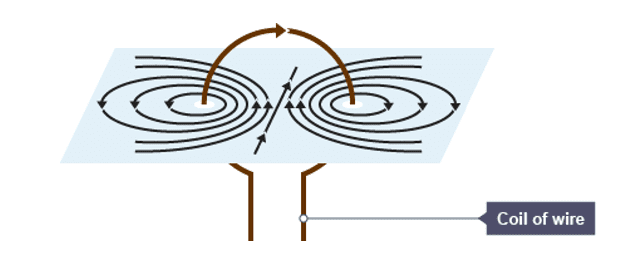
Solenoid
The wire can also be wrapped into a long coil. This coil is known as a solenoid.
The typical magnetic field pattern for a solenoid is show in the diagram below:
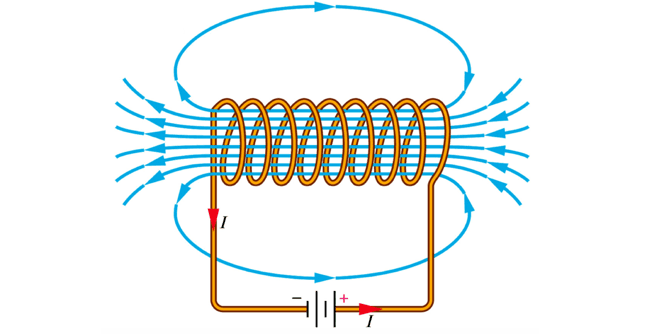
This image shows the coiled wire with current (I) passing through. The blue lines show the magnetic field that is created by this. Notice how similar the field lines are to a bar magnet. As shown by the diagram, inside the solenoid, the magnetic field lines are uniform and very close to each other. The closer the field lines are, the stronger the magnetic field is. This shows that the magnetic field is strongest inside the solenoid. Outside the solenoid around the coils, the magnetic field acts in the same way as it does around a bar magnet. The magnetic field lines are closer at the two ends of the coiled wire, showing that the magnetic field is strongest there. The magnetic field created by the solenoid is much stronger than that created by a straight wire or a flat circular coil.
In all three examples, the direction of the current flowing through the wire determines the direction of the magnetic field created. If the connections at the positive and negative terminal of the power source are reversed, the direction of the current is reversed and the direction of the magnetic field is also reversed.
The strength of the magnetic field created by the solenoid can also be changed. The field strength can be increased by:
- Increasing the current that flows through the solenoid
- Increasing the number of coils on the solenoid
- Wrapping the solenoid around a soft magnetic core such as iron
If a magnetic material is placed inside the solenoid, the magnetic field generated causes the material to become magnetic.
An electromagnet is a type of magnet where the magnetic field is created by the flow of an electrical current through a conductor. The use of straight wires or flat circular coils often creates only very weak magnetic fields so they are not useful electromagnets. Electromagnets are usually made of a solenoid wrapped around a magnetic metal core such as iron. A simple electromagnet is shown in the diagram below
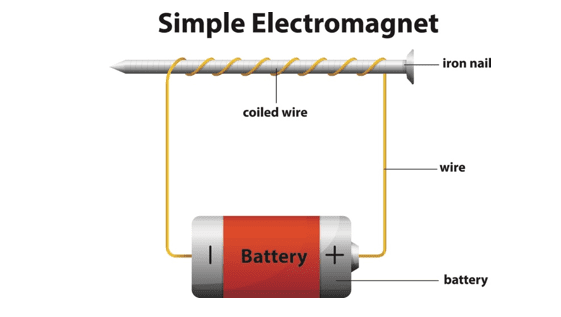
The magnetic field generated using electromagnets is very strong. Electromagnets are very useful to us because we are able to turn the magnetic field on or off using the current. If we stop the current, the magnetic field is turned off.
Electromagnets are often used in scrapyards for moving car bodies around. The current is switched on and the magnetic field generated is used to pick up the car body. When we want to drop the car we simply turn off the current and the magnetic field disappears. The car will no longer be attracted to the magnet and can then be dropped.
Passing a wire through a magnetic field
Charged particles such as ions or electrons can move through a magnetic field. If the charged particle is moving parallel to the direction of the magnetic field no force will be exerted on it. The particle will continue to move in the same direction as long as the magnetic field is in place. If the motion of the charged particle is not parallel to the magnetic field, a force will be exerted on it. The charged particle will move in different directions depending upon the direction of the magnetic field and the current applied.
Current is a flow of electrical charge carried by electrons which are charged particles. A simple magnetic field has a north and south pole. The magnetic field lines between these opposite poles are straight and flow from north to south. If we place a wire with a current flowing through into the middle of the poles so that it is perpendicular to the direction of the magnetic field, a force will be exerted on the electrons flowing through the wire.
The magnetic field created by the current-carrying wire interacts with the magnetic field between the poles causing the wire and magnets to exert a force on each other. The action of the magnetic field interaction and consequential forces exerted is known as the motor effect.
The motor effect is useful in simple direct current (d.c.) electric motors and loudspeakers. Simple d.c. motors contain a spindle attached to a negative and positive terminal. This spindle is attached to a current-carrying coil placed between two opposite magnetic poles. Some motors have the coil placed between two magnets whilst some simple motors have just one magnet.
The coil is able to rotate due to the motor effect. When the electrical current flows through the coil, a magnetic field is generated and the interaction between this magnetic field and the one created by the opposite poles of the magnet causes a force to be exerted on the wire.
For the motor effect to occur, the wire must be placed at a right angle to the magnetic field. If the wire is parallel to the magnetic field nothing will happen. The direction of the force exerted on the wire will always be at right angles to the direction of the current and magnetic field. One side of the wire will move upwards due to the upwards force and the other side will move downwards, as shown in the diagram below:
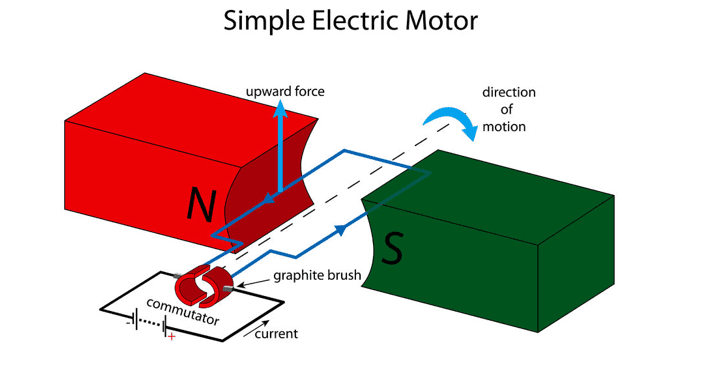
In this image we can see the rectangular coil spins due to the upward force exerted on one side. After one rotation, the force will need to be reversed otherwise the same force will be exerted on the other side and force the coil to stop rotating. The only way to reverse the force is to reverse the direction of the magnetic field, which itself can only be achieved by reversing the direction of the current flowing through the wire.
The commutator (also known as a split ring) shown in the diagram above, allows the current to be reversed without having to swap the wires at the terminals. The commutator is directly attached to the ends of the coil of wire and is able to spin with the wire. Graphite brushes are used to transfer electrical energy from the terminals to the commutator to make sure that the circuit is complete. The current is passed through the circuit causing the wire to spin.
When the wire begins to spin, the commutator will swap the direction of the current after each half turn. This causes the wire to continually spin rather than only completing half a rotation. Once the wire completes half a rotation, the current swaps and so the magnet now tries to align to this new magnetic system, so it continues to spin. Once another half turn is complete, the commutator flips the current again and the wire continues to rotate. This process happens again and again so the wire will constantly turn like a motor.
Electromagnets in loud speakers
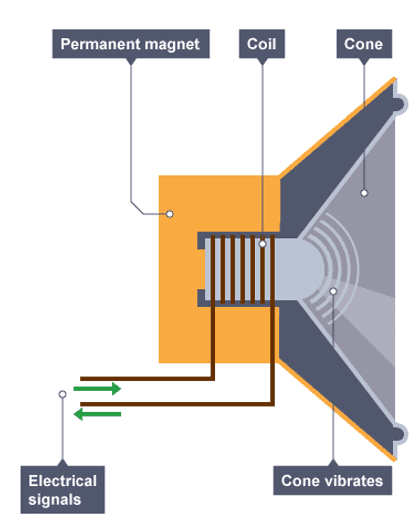
A speaker contains both a permanent magnet and an electromagnet. The electromagnet is placed inside the magnetic field of the permanent magnet and experiences a force. The electrical current from the amplifier is usually alternating current (a.c.) which means that it is continually changing direction. The two poles in the permanent magnet do not change but the ones in the electromagnet will reverse when the direction of the current is changed. This means that the electromagnet will be attracted to the permanent magnet when the current travels one way and repelled when the current is in the opposite direction. This constant attraction and repulsion causes the electromagnet to move, which in turn causes the speaker cone to move backwards and forwards. The movement of the cone generates vibrations of the air particles. These vibrations are sound waves which are then received by us and interpreted by the brain as sound.
The size of the force on the wire can change depending on the size and direction of the magnetic field and current applied. An increase in the current applied or the strength of the magnetic field, causes the force on the wire to increase.
The higher the force on the wire, the faster the wire will rotate. If we want our d.c. motor to spin faster, therefore, we can either increase the size of the current by increasing the voltage used on the power supply, or increase the strength of the magnetic field. We can change the direction in which the motor turns by reversing the current or reversing the direction of the magnetic field.
The left-hand rule
The direction in which the wire will spin depends upon the direction of the resulting force created. We can predict the direction of rotation as long as we know the direction of the current and the direction of the magnetic field. The method for predicting the direction of rotation uses the left-hand rule. This rule is also known as ‘Flemings left-hand rule’.
To use the left-hand rule, you point your first finger in the direction of the magnetic field from north to south, and your second finger in the direction of the current from positive to negative. The position of your thumb shows the direction of the movement of the wire.
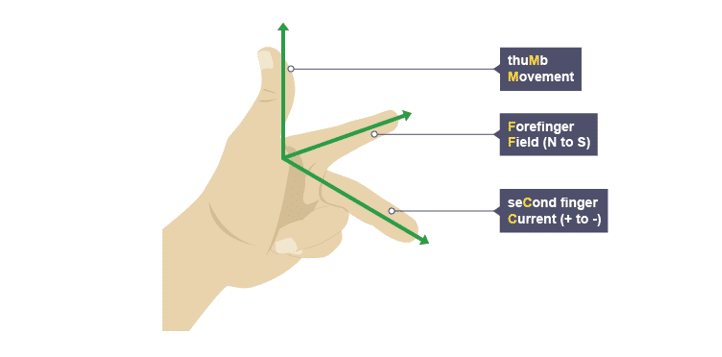
If the current is reversed, the field is also reversed and the direction of the thumb turns through 180o.

